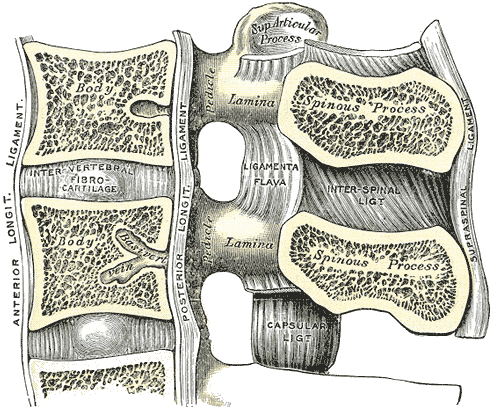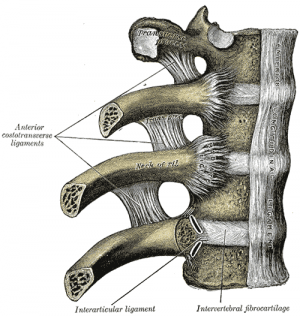Thoracic Ligaments
Original Editor - User:Lucinda hampton
Top Contributors - Lucinda hampton and Kim Jackson
Introduction[edit | edit source]
Ligaments are fibrous bands of connective tissue that attach to bone.
The system of ligaments in the vertebral column, combined with the tendons and muscles, provides a natural brace to help protect the spine from injury.
Ligaments
- Connect two or more bones together and help stabilize joints (cf tendons which attach muscle to bone).
- Aid in joint stability during rest and movement and help prevent injury from hyperextension and hyperflexion (excessive movements)[1].
Thoracic Ligaments[edit | edit source]
The thoracic spine is strengthened by the presence of numerous ligaments.
There are two primary ligament systems in the spine, the intrasegmental and intersegmental systems:
- The Intrasegmental System holds individual vertebrae together and includes the ligamentum flavum, interspinous, and the intertransverse ligaments.
- The Intersegmental System holds a group of vertebrae together. The intersegmental system includes the anterior and posterior longitudinal ligaments and the supraspinous ligaments.
Present Throughout Vertebral Column[2][3]
| 'Ligament Name' | 'Description' |
|---|---|
| ''''''''''Anterior Longitudinal Ligament (ALL)''''''''''
A primary spine stabilizer |
About one-inch wide, the ALL runs the entire length of the spine from the base of the skull to the sacrum. It connects the front (anterior) of the vertebral body to the front of the annulus fibrosis. |
| '''''''Posterior Longitudinal Ligament (PLL)'''''''
A primary spine stabilizer |
About one-inch wide, the PLL runs the entire length of the spine from the base of the skull to sacrum. It connects the back (posterior) of the vertebral body to the back of the annulus fibrosis. |
| ''''Supraspinous Ligament'''' | This ligament attaches the tip of each spinous process to the other. |
| '''''''Interspinous Ligament''''''' | This thin ligament attaches to another ligament called the ligamentum flavum that runs deep into the spinal column. |
| ''''''''''Ligamentum Flavum''''''''''
The strongest ligament |
This yellow ligament is the strongest. It runs from the base of the skull to the pelvis, in front of and between the lamina, and protects the spinal cord and nerves. The ligamentum flavum also runs in front of the facet joint capsules. |
Ligaments Unique to Thoracic Spine[edit | edit source]
A number of small ligaments also support the costovertebral joints:
- Radiate ligament of head of rib – Fans outwards from the head of the rib to the bodies of the two vertebrae and intervertebral disc.
- Costotransverse ligament – Connects the neck of the rib and the transverse process.
- Lateral costotransverse ligament – Extends from the transverse process to the tubercle of the rib.
- Superior costotransverse ligament – Passes from the upper border of the neck of the rib to the transverse process of the vertebra superior to it[3].
Clinical Significance[edit | edit source]
- Car or sports accidents along with falls are the leading cause of injuries or trauma to the ligaments of the spine.
- A ligament can overstretch, become twisted, tear, or break as a result of trauma.
- The muscles surrounding the ligaments compensate for the injury which results in painful muscle spasms, a protective mechanism to prevent further damage or stretching of the ligaments.
- The degree of injury and treatment determines the outcome resulting in complete healing and in other cases, chronic or recurring pain.
- Types of jobs that are the worst for back and ligament strain include office workers, nurses, manual laborers, construction and factory workers, dentists, drivers, and auto mechanics.
- Poor posture (see image) can cause ligament injury over time. eg Slumping over while standing for long periods of time is the result of muscle fatigue as this places the entire weight of the body on certain regions of the spine which affects the pressure on the ligaments. Thos results in overstretched and become weakened ligaments. Muscles compensate causing gait and posture to become more abnormal. Standing becomes even more difficult and painful.
- Workplace hazards such eg lifting items repeatedly, lifting heavy objects incorrectly, computer work with poor posture all contribute to muscle and ligament damage which over time may become permanent.[4]
References[edit | edit source]
- ↑ Colorado soune inst. Ligamants, tendons, muscles Available from:https://www.coloradospineinstitute.com/education/anatomy/ligaments-tendons-muscles/ (last accessed 11.5.2020)
- ↑ borophysiotherapy Thoracic ligaments Available from:https://twinboro.com/body/spine/thoracic/thoracic-muscle-ligament-nj.html (last accessed 11.5.2020)
- ↑ 3.0 3.1 teachmeanatomy Throacic spine Available from:https://teachmeanatomy.info/thorax/bones/thoracic-spine/ (last accessed 11.5.2020)
- ↑ spine connection Back pain conditions Available from:https://spineconnection.org/back-pain-conditions/ligament-injuries/ (last accessed 11.5.2020)









